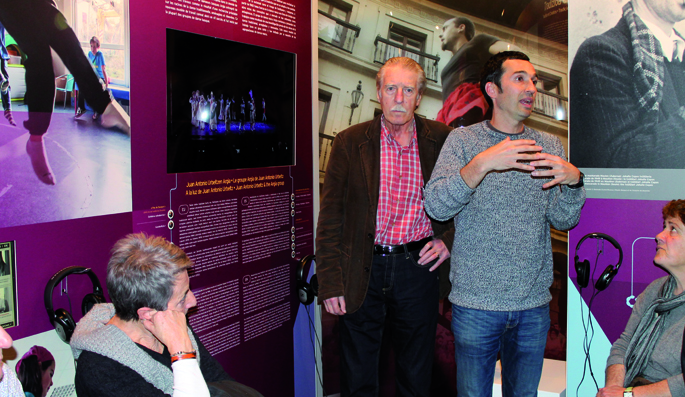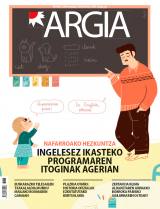Dance knots

Multimedia, in four languages, 150 square meters, more than 400 illustrations, old films and almost unknown files so far, three-dimensional images, own video creations… These are the characteristics of the Soka exhibition organized by Euskal Kultur Erakundea, if you want technical sheet. During these weeks, until 2 April, you can see and hear at the Koldo Mitxelena Kulturunea in Donostia, where he will go afterwards.
This data would be enough, if you don't trust my word to know that we're talking about an exhibition that is valuable by itself. But one thing is that and another is, moreover, to immerse yourself in it under the direction – forgive me – of the two main poles of traditional Basque dance today.
We enjoyed this opportunity in the afternoon of February 25. We started in Soka with the hand of Oier Araolaza and Juan Antonio Urbeltz, and in this case the phrase is not metaphorical: they really asked us to grab our hands to start the guided tour. When we were that way, we learned for at least 500 years that not only was dancing, but had also channeled couples in the squares of the Basque Country, until in the 18th century the Church proclaimed sin the obscene contact of the skins and in its place the scarf.
“That was the beginning of the end,” says Araolaza, “when the youths lost their role they left the soka-dantza.” The second blow was to move from the routine of working as a team to the gymnastic exhibition of an individual, which is today the aurresku. In any case, the tradition of Soka-Dantza is that the Basques are very egalitarian, as Juan Antonio Urbeltz explained. “That’s why we don’t have a heroic myth.”
Once the hands were untied, we moved from one part to the other of the exhibition, following a certain mechanics: Araolaza asked, Urbeltz replied. He responded prodigiously, sometimes a little bit chaotic, integrating experiences into an eruditionary ocean. Some studied: tradition and creation are perfectly compatible if done well; in the invention it also owes fidelity to the heritage received; and there are no indications of Basque dancers who were in the court of the kings of France in the historical record, but there are indications in relation to the court of Milan.
The gender panel was the last knob on the string. “Here are the oldest images of the exhibition,” said Oier Araolaza, “it is curious because the oldest thing we have is that of a woman; it has often been said that Basque dance has been danced mostly by men, and here we can see women dancing the aurresku in 1921 in honor of a group of remers.” Women and group, holding hands. Things banned by the 20th century.
Donostiako Koldo Mitxelenako Ganbara aretoan ikusgai dago, apirilaren 2ra arte, Euskal Kultur Erakundeak ekoiztutako Soka, euskal dantzaren urratsetan erakusketa ibiltaria, 2015eko irailean Biarritzen estreinatu zena. Otsailaren 25ean bisitaldi gidatua izan zen, Juan Antonio Urbeltz eta Oier Araolazaren eskutik.
The idea that we in the dance world often repeat is that dance is ephemeral. The Elhuyar dictionary gives as a counterpart to "ephemeral" English: ephemeral, destructive, perishable, ephemeral, ephemeral, perishable, perishable, ilaun. I don't remember who I first read that idea... [+]
Transmisioa eta dantza taldeetako erreleboa aztertu nahi izan dugu Dantzan Ikasi topaketetan, eta gazte belaunaldiek lan egiteko ereduak ezagutu nahi izan ditugu “Gazteen parte-hartzea euskal dantzan” mahai inguruan: Eder Niño Barakaldoko... [+]
Aste hondar honetan euskal dantzen hiriburu bilakatu da Hendaia. Akelarre dantza talde hendaiarraren 50. urtemugaren testuinguruan, Lapurdi, Baxe Nafarroa eta Xiberoako hamasei dantza talde elkartu ditu bertan Iparraldeko Dantzarien Biltzarrak.























